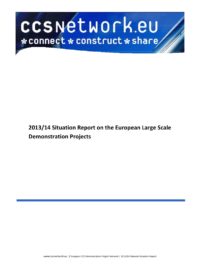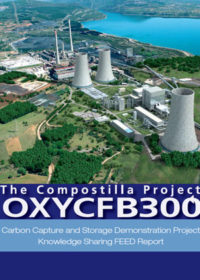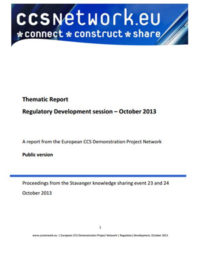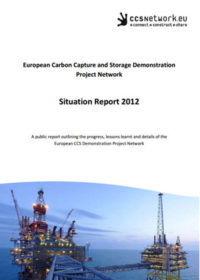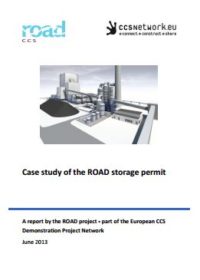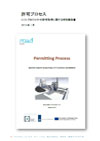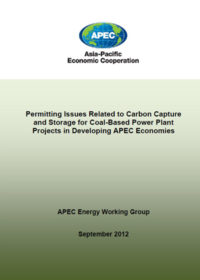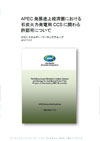Resources
Publications
Our publications, reports and research library hosts over 500 specialist reports and research papers on all topics associated with CCS.
View our Publication Library Disclaimer.
Filter by
Situation report 2013/14: European large scale demonstration projects
19th November 2014
Topic(s): Carbon capture use and storage (CCUS), Engineering and project delivery, Permitting, Policy law and regulation
This second edition of the European CCS Demonstration Project Network: Situation Report 2013/14 includes the findings related to the participating projects from both the knowledge sharing events, presentations, and the internal survey conducted via the Information and Experience Gathering (IEG) questionnaire. The report covers progress made by the projects in capture, transport, storage, regulatory development, public engagement and knowledge sharing within and beyond the Network.
Little has changed from previous reporting for the projects in terms of planning and following timelines. Almost all of them have experienced delays with various permits and with reaching a final investment decision (FID). In 2013, two projects, Porto Tolle and Compostilla received a negative FID. Ciuden, the academic partner of Compostilla project, remains however with collaborative status in the Network. The current timeline for the ROAD project suggests that they could be operating and injecting CO2 by 2017. For Don Valley project this is planned for 2018.
The Network is composed of one oxyfuel power project (former Compostilla), one IGCC power project which may also include gas oxyfuel technology (Don Valley), one post-combustion power project (ROAD) and a gas processing project (Sleipner). Sleipner is the only project currently in operation. All will capture over 1 million tonnes of CO2 per annum, at a capture rate of over 90%. SOx and NOx are quoted by the projects as the most common and expected impurities in the slip stream gas.
Disclaimer
The content within the Global CCS Institute Publications, Reports and Research Library is provided for information purposes only. We make every effort and take reasonable care to keep the content of this section up-to-date and error-free. However, we make no claim as to its accuracy, currency or reliability.
Content and material featured within this section of our website includes reports and research published by third parties. The content and material may include opinions and recommendations of third parties that do not reflect those held by the Global CCS Institute.
OXYCFB300 Compostilla Carbon Capture and Storage Demonstration Project: knowledge sharing FEED report
21st February 2014
Topic(s): Carbon capture use and storage (CCUS), CO2 capture, CO2 storage, CO2 transport, Health safety and environment, Permitting, Policy law and regulation
This report describes the lessons learned and provides detailed knowledge from the expert multidisciplinary teams - including mechanical, electrical and civil engineers, geologists, ecologists, lawyers, accountants – that carried out the extensive Front End, Engineering and Design (FEED) study of the full chain OXYCFB300 Project.
This document summarises all the engineering studies and considerations developed during the FEED. From the original conceptual idea, FEED engineering works have yielded a functional and technically feasible power plant, which successfully integrates oxycombustion technology with a state-of-the-art ultrasupercritical regenerative power cycle and with an innovative CO2 purification and compression process, integrated with a transport line that conducts the CO2 at dense phase to the final CO2 geologic sequestration site, for an operational life of 25 years.
Disclaimer
The content within the Global CCS Institute Publications, Reports and Research Library is provided for information purposes only. We make every effort and take reasonable care to keep the content of this section up-to-date and error-free. However, we make no claim as to its accuracy, currency or reliability.
Content and material featured within this section of our website includes reports and research published by third parties. The content and material may include opinions and recommendations of third parties that do not reflect those held by the Global CCS Institute.
Thematic report. Regulatory development session: October 2013
24th October 2013
Topic(s): Carbon capture use and storage (CCUS), Permitting, Policy law and regulation
This meeting included an update from the European Commission, detailed project updates from Don Valley, Compostilla and ROAD, an update on the current policy, legal, regulatory activities within ZEP.
Disclaimer
The content within the Global CCS Institute Publications, Reports and Research Library is provided for information purposes only. We make every effort and take reasonable care to keep the content of this section up-to-date and error-free. However, we make no claim as to its accuracy, currency or reliability.
Content and material featured within this section of our website includes reports and research published by third parties. The content and material may include opinions and recommendations of third parties that do not reflect those held by the Global CCS Institute.
Situation report 2012: a public report outlining the progress, lessons learnt and details of the European CCS Demonstration Project Network
1st October 2013
Topic(s): Carbon capture use and storage (CCUS), CO2 capture, CO2 storage, Engineering and project delivery, Permitting, Policy law and regulation
The European Carbon Capture and Storage Demonstration Project Network's Situation Report 2012 is a publication from a community of large scale projects dedicated to knowledge sharing (the Network). This report is intended for those interested in some of the specific technical, regulatory and project management considerations of carbon capture and storage (CCS) as a large-scale, low-carbon technology for the electricity generation and industrial sectors (steel, iron, chemical, methanol, gas process, cement, etc.).
This report provides both a brief outline of the major elements within the development and running of a CCS project, and specific details generated by the Network. While a number of thematically specific reports are regularly made public by the Network, this report attempts to provide an overall outline of the technical details, lessons learnt, challenges and progress facing the carbon capture and storage (CCS) projects within the Network.
The Situation Report 2012 covers developments during 2012. Primarily drawing on the data provided by the projects within a six monthly survey, information is also taken from the eight knowledge sharing workshops held by or with the Network, and specific reports generated by this body of large-scale projects.
Disclaimer
The content within the Global CCS Institute Publications, Reports and Research Library is provided for information purposes only. We make every effort and take reasonable care to keep the content of this section up-to-date and error-free. However, we make no claim as to its accuracy, currency or reliability.
Content and material featured within this section of our website includes reports and research published by third parties. The content and material may include opinions and recommendations of third parties that do not reflect those held by the Global CCS Institute.
Case study of the ROAD storage permit
1st June 2013
Topic(s): Carbon capture use and storage (CCUS), CO2 storage, Permitting
Disclaimer
The content within the Global CCS Institute Publications, Reports and Research Library is provided for information purposes only. We make every effort and take reasonable care to keep the content of this section up-to-date and error-free. However, we make no claim as to its accuracy, currency or reliability.
Content and material featured within this section of our website includes reports and research published by third parties. The content and material may include opinions and recommendations of third parties that do not reflect those held by the Global CCS Institute.
ROAD CCS permitting process: special report on getting a CCS project permitted
4th January 2013
Topic(s): Carbon capture use and storage (CCUS), Permitting, Policy law and regulation
Disclaimer
The content within the Global CCS Institute Publications, Reports and Research Library is provided for information purposes only. We make every effort and take reasonable care to keep the content of this section up-to-date and error-free. However, we make no claim as to its accuracy, currency or reliability.
Content and material featured within this section of our website includes reports and research published by third parties. The content and material may include opinions and recommendations of third parties that do not reflect those held by the Global CCS Institute.
許可プロセス: CCS プロジェクトの許可取得に関する特別報告書
4th January 2013
Topic(s): Carbon capture use and storage (CCUS), Permitting, Policy law and regulation
ROADプロジェクトは、オランダでは初めてとなるこの種のプロジェクトであり、必要とされる全ての許可申請は、本プロジェクトで最も困難な点の一つであった。CCSプロジェクトは実際のところ、CCS指令の規定や広範な認可当局が関与していることに起因した複雑で時間のかかる許可プロセスに直面している。
Disclaimer
The content within the Global CCS Institute Publications, Reports and Research Library is provided for information purposes only. We make every effort and take reasonable care to keep the content of this section up-to-date and error-free. However, we make no claim as to its accuracy, currency or reliability.
Content and material featured within this section of our website includes reports and research published by third parties. The content and material may include opinions and recommendations of third parties that do not reflect those held by the Global CCS Institute.
Dedicated CCS legislation
6th September 2012
Topic(s): Liability, Permitting, Policy law and regulation
International policy makers are increasingly viewing CCS technology as an appealing climate change mitigation option. However, as yet there is no overarching international agreement or regulatory framework governing the 'full-chain' of CCS activities, either onshore or offshore.
Various amendments have been made to the international and regional marine agreements, as well as proposals for new accounting methodologies under the international climate change agreements. As things progress, with many jurisdictions seeking to develop similar regulatory frameworks, it will be important to monitor the relationship between international, supranational, national and sub-national legislation.
1. EU Directive on the geological storage of CO2 (2009/31/EC)
EU Member States have an obligation under EU law to transpose the provisions of the CCS Directive into national law and must communicate the text of any such laws and other administrative measures to the European Commission. The deadline for communication specified in the Directive was 25 June 2011.
- Communication on the future of CCS in the EU
- Motion for a European Parliament Resolution - Davies Report
- Transposition of the EU Directive (2009/31/EC)
2. Australian CCS legislation
CCS legislation in the Australian context.
3. Canadian CCS legislation
CCS legislation in Canada.
4. Danish CCS legislation
CCS legislation in Denmark.
5. French CCS legislation
CCS legislation in France.
6. German CCS legislation
CCS legislation in Germany.
7. Norwegian CCS legislation
CCS legislation in Norway.
8. Dutch CCS legislation
CCS legislation in The Netherlands.
9. United Kingdom CCS legislation
CCS legislation in the UK including:
- Consultation: Towards Carbon Capture and Storage
- Consultation: Guidance on carbon capture readiness and applications
- Consultation on a framework for the development of clean coal
- Consultation on draft supplementary guidance for new coal power stations
- Consultation on the proposed offshore CO2 storage licensing regime
- Consultation on draft national policy statements for energy infrastructure
- Consultation on amendments to Pipeline Safety and Health and Safety Regulations
- Consultation on Environmental Permitting Regulations
- Consultation on CCS Directive and call for evidence on development of CCS infrastructure
- Consultation on electricity market reform
- Pollution Prevention Control amendment regulations consultation 2011
Disclaimer
The content within the Global CCS Institute Publications, Reports and Research Library is provided for information purposes only. We make every effort and take reasonable care to keep the content of this section up-to-date and error-free. However, we make no claim as to its accuracy, currency or reliability.
Content and material featured within this section of our website includes reports and research published by third parties. The content and material may include opinions and recommendations of third parties that do not reflect those held by the Global CCS Institute.
Permitting issues related to carbon capture and storage for coal-based power plant projects in developing APEC economies
1st September 2012
Topic(s): Carbon capture use and storage (CCUS), Permitting, Policy law and regulation
This study examines Carbon capture and storage legal and regulatory regimes for nine developing APEC economies: People’s Republic of China, Indonesia, Republic of Korea, Malaysia, Mexico, the Philippines, Chinese Taipei, Thailand and Viet Nam.
These APEC economies were selected for this study based on four criteria:
- the economy is considered a developing economy
- the economy consumes a significant amount of coal as fuel for electricity generation
- the economy possesses potential CO2 storage capacity, and
- the economy has a likely need for CCS to achieve greenhouse gas emissions reductions and / or the presence of policies that offer an enabling environment for CCS.
Disclaimer
The content within the Global CCS Institute Publications, Reports and Research Library is provided for information purposes only. We make every effort and take reasonable care to keep the content of this section up-to-date and error-free. However, we make no claim as to its accuracy, currency or reliability.
Content and material featured within this section of our website includes reports and research published by third parties. The content and material may include opinions and recommendations of third parties that do not reflect those held by the Global CCS Institute.
APEC 発展途上経済圏における石炭火力発電用CCS に関わる許認可について
1st September 2012
Topic(s): Carbon capture use and storage (CCUS), Permitting, Policy law and regulation
アジア太平洋経済協力会議 (APEC)の発展途上 諸国は、世界で最も急速に成長している経済圏であり、今後数十年間に発電量を大きく拡大する必要がある。この新規電源の多くは、化石燃料、特に石炭に依存する可能性が高い。地球規模の気候変動及び地域に急速に拡大する石炭火力発電部門からの二酸化炭素 (CO2) 排出量の増加に対する懸念から、これらの発電所からの排出CO2の回収貯留(CCS)をいつ実行できるかという問題が生じている。石油増進回収 (EOR) などのCO2 利用と組み合わせることができるCCS 技術は、多くの発展途上APEC 諸国で急速に拡大する石炭火力発電部門からのCO2排出量の劇的な増加に対処する実行可能な技術解決策となる。
Disclaimer
The content within the Global CCS Institute Publications, Reports and Research Library is provided for information purposes only. We make every effort and take reasonable care to keep the content of this section up-to-date and error-free. However, we make no claim as to its accuracy, currency or reliability.
Content and material featured within this section of our website includes reports and research published by third parties. The content and material may include opinions and recommendations of third parties that do not reflect those held by the Global CCS Institute.
Property rights in relation to CCS
30th August 2012
Topic(s): Liability, Permitting, Policy law and regulation
- Overview
- Relevance to CCS
- What are the key applicable laws and principles?
- Key legal issues concerning CCS
Overview
The concept of property is concerned with the ownership of tangible or intangible things. Property rights can be conceived of as a bundle of rights that include, in addition to the right to own, the right to use and the right to enjoy. Property law comprises the rules and principles governing these proprietary rights. Legal principles concerning property often vary between different national and sub-national jurisdictions, but there are common concepts and questions that need to be asked when dealing with CCS issues.
Law uses the term 'property' in a number of different ways. 'Real property' refers to property of the land and anything growing on it, attached to it or built on it. Real property includes the physical property of the land, such as soil, and fixed assets such as buildings. More importantly, it includes legal rights concerning the land, such as a right of way or the right to extract minerals. Private property can refer to tangible assets over which the owner has exclusive and absolute rights, such as the wellhead equipment at a CO2 injection operation. The last is public property, which is not restricted to any one individual's use or possession and is owned by a public body. Intellectual property comprises commercially valuable products of the human intellect, such as a patentable capture technology. Though relevant to the commercial development of CCS, it will not be discussed in this section.
Relevance to CCS
Property rights are a key legal aspect of CCS operations. Determining property interests at a storage site is essential to acquiring the necessary surface and subsurface rights for injecting and storing CO2 in the target geological formation. Where CO2 is transported to the site by pipeline, property rights for constructing pipeline infrastructure must also be considered. The process by which property rights are granted to an operator can affect the cost of the overall CCS operations. Establishing how these rights are acquired, maintained or transferred over the lifetime of the project has implications for managing the liability for CCS projects. Liability for CO2 during the active injection phase of a project generally lies with the operator, who must have a right to store in the subsurface formation into which the CO2 is being injected. The right to this storage plus the stored CO2 must follow the entity that takes on the long-term stewardship of the storage site, whether it remains with the operator or is handed over to the state.
The legal treatment of property rights for CCS is frequently based on regimes governing property rights for natural resources. Mineral rights regimes are of particular interest given the analogous nature of oil and gas operations to CO2 transport and storage activities. Water rights are also pertinent since underground saline formations have significant potential for large-scale storage.
What are the key applicable laws and principles?
Land ownership
Historically, real property rights were based on the traditional principle that the owner of a piece of land owns everything above it and below it to an infinite extent. (This is the Cuius est solum, eius est usque ad coelum et ad inferos maxim, meaning 'whoever owns the soil, it is theirs up to Heaven and down to Hell' normally called the 'ad coelum doctrine'.) Thus, the owner of a piece of land would have exclusive rights to the surface and also any subsurface mineral interests. A mineral interest constitutes the rights to search for, develop and remove minerals from the subsurface. The surface estate includes all the rights to the real property of the land excluding the mineral interest. It can include subsurface substances not deemed to be minerals, such as gravel or water resources.
Property rights have evolved, and often the mineral interests have become separated from the ownership of the surface either through outright sales or a lease, resulting in different owners of each. In many jurisdictions, such as Australia, many countries of the European Union and Latin America, the mineral interest is vested in the state, resulting in no private ownership of minerals. In these jurisdictions, the state grant licences for the exploration and extraction of minerals beneath a surface owner's land. In a country such as the United Kingdom some minerals (coal, gas, gold and silver) have been acquired by the State under legislation, but other minerals remain with the landowner. Conversely, in the United States, all mineral interests in principle are privately held and cannot be expropriated by the state without compensation.
In the context of CCS, the most important component of the property interest is the subsurface pore space. In simple terms, pore space is the geological formation where CO2 is stored. With regard to storage in depleted hydrocarbon reservoirs, the ownership of the geological formation varies between jurisdictions. In some jurisdictions, such as Canada, ownership of the geological formation remains with the owner of the mineral interest after the minerals have been extracted. In others, such as in many US states, ownership of the geological formation remains associated with the surface estate. In jurisdictions where the mineral interest is owned by the state, pore space is typically also vested in the state, though this is not always clearly specified by existing laws. In some jurisdictions, legislation has now been passed to make clear that the state owns the pore space, for example, in the Province of Alberta in Canada.
Where mineral rights are in principle vested in the owner of the land but are now held by someone else (either through a sale or a lease), difficult legal questions can arise as to who owns the pore space for storing CCS - the owner of the mineral rights or the original landowner? Similar questions can arise for storage in saline formations, though the ownership of pore space in this type of formation may follow ownership of water resources more generally. In any event, it is likely to be important to look at the precise terms of the sale or lease of mineral interests relating to individual storage sites to determine the exact circumstances.
Property rights in the marine environment differ from onshore. In deciding who owns storage rights below the sea bed, it will be important to distinguish between the territorial waters of a state and the high seas. For further information on offshore property rights and governance see the UNCLOS page.)
Land use
An owner of land may enjoy any kind of right over it, including creating subsidiary interests in the property that allow others to use or benefit from the land. There are a number of different types of subsidiary interests used in the CCS context:
- Lease: A conveyance of a possessory interest that gives the tenant the exclusive right to use and enjoy land for a specified period of time in exchange for some sort of remuneration (e.g. payment). Oil and gas production activities are typically carried out under a lease agreement. Similarly, some jurisdictions already have processes in place to grant leases for CO2 storage sites (e.g. the United Kingdom);
- Licence: A grant of permission by the owner to an individual or entity to use the real property for a specific purpose. Unlike a lease, it does not transfer interest in the real property to the licence holder. It is not assignable and may be terminated or revoked by the owner at any time;
- Easement: The right of one estate owner to use or control the land of another for a specific limited purpose. Unlike a lease or licence, an easement may last forever, but it does not give the holder the right to possess, take from, improve, or sell the land. A good example of an easement is the right-of-way granted by a landowner to build a CO2 pipeline on private land; and
- Covenant: An agreement, usually in the form of a contract or deed between estate owners, that real property will be used in a certain way. A covenant may constitute a pledge to do something or refrain from doing something. A simple example of a covenant is the requirement to fence in surface installations at a CO2 injection site.
Acquiring property rights
Property rights may be acquired through voluntary means, involuntary means or adverse possession. Where land is privately owned, the landowner can decide to sell it or lease the surface or mineral interest to another private entity. Similarly, interests in publicly owned land can be sold or allocated for use to a private entity. In other cases, without requiring the consent of the private landowner, the state may have the power to take private property for its own use or to authorise the use of private property by a third party. Depending on the legal regime, the state may have to compensate the landowner for the property. These involuntary means of acquiring private property have different terms in different jurisdictions: eminent domain, compulsory purchase/acquisition, resumption, and expropriation. Lastly, property may be obtained through adverse possession of another's land for a continuous and uninterrupted period of time.
Illegitimate entry and interference
Also relevant to the discussion of property rights and CCS are the property rights of adjacent landowners in the event of activities that infringe on the property of another. Examples could be unintended migration of CO2 outside a selected storage area or impacts on a mineral resource from injected CO2. A landowner or tenant enjoys protection from illegitimate entry onto or interference with his property. Any wrongful entry on his real property constitutes a trespass. Any activity or situation that interferes with his use or enjoyment of property constitutes a nuisance. The landowner may take legal action to seek to stop an activity deemed to be trespass or nuisance or to recover damages incurred. In the CCS context, some instances of trespass are unambiguous. For example, where mineral and surface interests are severed, unauthorised use of the surface to access the subsurface would be considered trespass. However, in a case where substances injected into the subsurface migrate unexpectedly to neighbouring land, determining whether trespass has occurred is less straightforward.
International legal context
International law does not generally regulate real property rights, leaving these issues to be dealt with under national law. As an example, international law is silent on whether natural resources should be held in either public or private ownership. However, international law does play a role in regulating the enjoyment of such property rights by foreign nationals within the host state's borders. This is found particularly in the field of foreign investment law and international human rights.
Despite its silence on how property rights over natural resources and land should be regulated, international law imposes some restrictions on the way a state exploits the natural resources that are either under its sovereignty, shared by multiple states or held in common by all states. General obligations to exercise due diligence and adopt a preventative/precautionary approach in the use of a state's territory are imposed under international law in order to avoid transboundary harm to the territory of other states. States' cooperation in conservation, sustainable utilisation, and environmental protection are also required with respect to the exploitation of shared resources or resources in areas beyond national jurisdiction.
Key legal issues concerning CCS
- Pore space ownership has yet to be clearly articulated in some jurisdictions, resulting in uncertainty for permitting CO2 storage operations. In jurisdictions where the mineral interest is vested in the state, it is often assumed that the state also owns the pore space. However, governments that have declared ownership of valuable subsurface substances (e.g. coal and hydrocarbons), have allowed ownership of other subsurface substances to remain with the surface estate. For example, less valuable subsurface resources such as sand and limestone are sometimes associated with the surface estate. Therefore it is not necessarily clear that pore space would be automatically vested in the state just because there is no private ownership of the mineral interest. Some governments have resolved this issue by declaring that ownership of pore space is vested in the state. This was done, for example, in the Canadian Province of Alberta. In the United States, this type of declaration would not be possible without compensating landowners, since private ownership of the mineral interest is extensive.
- In many jurisdictions there is still no process for allocating CO2 storage rights or granting access to the subsurface. This process must consider competing uses of the property in question, especially how to prioritise CO2 storage rights versus oil and gas production.
- The duration of a right to store CO2 is linked to the long-term liability of the storage operation. In the predominant model for managing liability, the liability is transferred to a public body after closure once a series of conditions have been met. Where the pore space was owned or leased by a private entity during the operational phase, the rights to the pore space will have to be transferred to the public body taking on the liability for the site.
Disclaimer
The content within the Global CCS Institute Publications, Reports and Research Library is provided for information purposes only. We make every effort and take reasonable care to keep the content of this section up-to-date and error-free. However, we make no claim as to its accuracy, currency or reliability.
Content and material featured within this section of our website includes reports and research published by third parties. The content and material may include opinions and recommendations of third parties that do not reflect those held by the Global CCS Institute.
CCS liability legislation
30th August 2012
Topic(s): Liability, Permitting, Policy law and regulation
This section considers the legislation around liability in relation to CCS in Europe and Australia.
1. Liability under the European CCS Directive on the storage of CO2
We consider the liability provisions of the EU Directive on the geological storage of carbon dioxide and related legislation:
- Environmental Liability Directive (2004/35/EC)
- European Commission Guidance Documents Overview
- Summary and analysis of EC Guidance Document 3
- Summary and analysis of EC Guidance Document 4
2. Liability in Australian law for CCS activities
The Federal regulatory framework for offshore CCS activities is unique in Australia in that it provides mandatory indemnification by the Commonwealth Government for specified long-term liabilities.
Disclaimer
The content within the Global CCS Institute Publications, Reports and Research Library is provided for information purposes only. We make every effort and take reasonable care to keep the content of this section up-to-date and error-free. However, we make no claim as to its accuracy, currency or reliability.
Content and material featured within this section of our website includes reports and research published by third parties. The content and material may include opinions and recommendations of third parties that do not reflect those held by the Global CCS Institute.
